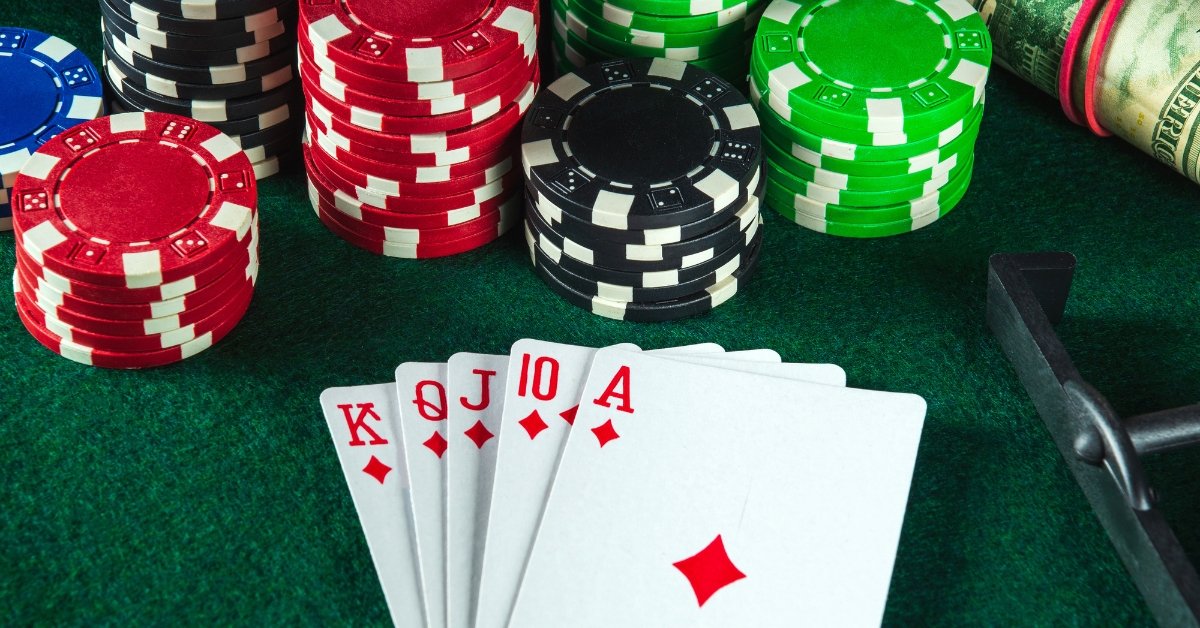Table Of Contents
Poker
Imagine sitting at a poker table, chips piled high, cards in hand, and all eyes on you.
The tension is thick, but you are calm—because you have mastered the art of poker.
Alternatively, at least you are on your way there!
Whether you dream of taking home the grand prize at a high-stakes tournament or want to impress your friends on poker night, mastering the basics is your first step.
However, do not worry—learning poker does not have to feel like cramming for an exam.
We will make it fun, engaging, and funny.
Before you can start winning, you need to speak the language of poker, which begins with understanding the different hands.
Think of this as learning the ABCs before writing a novel.
Here is a quick crash course on the poker hands that will make or break your game:
- Royal Flush: The king of all poker hands (pun intended). Picture this: a 10, Jack, Queen, King, and Ace, all in the same suit. It is like finding a unicorn—it is that rare and unbeatable.
- Straight Flush: Five consecutive cards of the same suit. Imagine you have got 5-6-7-8-9, all hearts. It is not a royal flush but close enough to make you feel like royalty.
- Four of a Kind: Four cards of the same rank. Think four aces, and you are on top of the world—or at least the poker table.
- Whole House: Three of a kind paired with a pair. It is like having your cake and eating it too. Three 7s and two 10s? That is a whole house of awesomeness.
- Flush: Any five cards of the same suit, not in sequence. All hearts, all diamonds—whatever suits you best, as long as they match.
- Straight: Five consecutive cards of different suits. Like your morning coffee, a straight is reliable and does the job.
- Three of a Kind: Three cards of the same rank. It is not flashy but solid—like the dependable friend who always has your back.
- Two Pair: Two cards of one rank, two cards of another. Double trouble, in a good way.
- One Pair: Two cards of the same rank. It is a modest hand but can still take the pot in the right situation.
- High Card: When nothing else works, it is down to the highest card. Think of it as the tiebreaker when all else fails.
Pro Tip: Print a cheat sheet with these hands and keep it by your side as you play. It is like training wheels for poker—there is no shame in using them until you can ride solo.
Dealing The Drama: How A Round Of Texas Hold ’em Unfolds
All right, you have got the basics, hands down. Now, let us dive into how the game plays out.
Texas Hold ’em is where it is, so let us walk through a round—complete with a small quantity of flair.
Step 1: Blinding Them With Science (Or Just Blinds)
The game starts with two players posting the blinds—no, not the kind you hang on your windows.
The player to the dealer’s left posts the small blind, and the next player posts the big blind.
These are forced bets to get the action started.
Step 2: The Dealer’s Magic Touch
Next, the dealer hands out two face-down cards to each player.
These are your hole cards.
Treat them like your most prized secrets—keep them close, and do not let anyone see them.
Step 3: The Betting Begins
Now comes the first round of betting.
This is where you decide whether to bet, call, raise, or fold.
It is like the dating world—you decide to go all in, play it cool, or cut your losses and walk away.
Step 4: The Flop—Where Things Get Real
The dealer then reveals the flop—three community cards placed face-up in the center of the table.
These are the cards everyone can use to make their hand.
This is where you start to see if your hole cards are the beginning of a beautiful friendship or a tragic love story.
Step 5: The Turn—The Plot Thickens
After another betting round, the dealer adds a fourth card to the community pool.
This is called the turn. It is like the middle of a novel—things are heating up, and the stakes are increasing.
Step 6: The River—The Big Reveal
The fifth and final community card, the river, is revealed after one last betting round.
This is the story’s climax, where all your careful planning (or reckless bluffing) comes to fruition.
Step 7: The Showdown—And The Oscar Goes To
After all the betting, it is time for the showdown. Players reveal their cards, and the best hand takes the pot.
It is like the final scene of a movie—you either walk away a hero or slink off to the credits.
Pro Tip: Keep that poker face vital, even if you need more confidence in your hand. Sometimes, winning is not about having the best cards—it is about convincing everyone else that you do.
Betting And Bluffing: The Art Of The Game
Poker is as much about psychology as it is about the cards.
Let us talk strategy—specifically, how to use betting and bluffing to your advantage.
Reading The Room: Guesstimating The Risks
When you first look at your hole cards, ask yourself:
“Am I holding gold or fool’s gold?” High pairs, consecutive numbers, or cards of the same suit are good signs.
However, remember that a substantial bluff can win the pot even if your hand is weak.
The key is to read your opponents—are they confident or just pretending to be?
Bluffing Like A Pro
Bluffing is the poker equivalent of acting—it is all about selling a story.
If you have nothing, but your opponent is hesitating, a bold bet might scare them off.
However, beware—the best bluffers know when to fold, too.
Knowing When To Fold
It is easy to get attached to your cards, but one of the hardest lessons in poker is knowing when to walk away.
Sometimes, the best move is to cut your losses and wait for a better hand.
Practice Makes Perfect: Sharpening Your Skills
No one becomes a poker pro overnight.
It takes practice, observation, and a willingness to learn from mistakes.
Watching The Masters
One of the best ways to learn is by watching seasoned players.
Whether watching a high-stakes tournament on TV or playing a casual game with friends, please pay attention to how the pros handle their hands.
What can you learn from their betting patterns? How do they react under pressure?
Hosting Your Own Game
If you want to immerse yourself in poker, consider hosting your game.
Not only will this give you plenty of practice, but it also lets you control the pace and stakes of the game.
Plus, you get to be the dealer—meaning you can work on your shuffling skills and start mastering the game’s finer points.
Exploring Other Poker Variations
Once you are comfortable with Texas Hold ’em, why not explore other poker variants?
Games like Omaha and Seven-Card Stud offer new challenges and can keep things fresh.
Learning different poker games will make you a more versatile player, capable of handling any situation.
The Final Hand: From Beginner To Poker Aficionado
Poker is a game of skill, luck, and bravado.
Whether you are playing for pennies or at a high-stakes table, the thrill of the game is the same.
Mastering the basics, refining your strategy, and practicing regularly will help you grow more confident with each hand.
Remember, every poker pro was once a beginner—what matters is your willingness to learn and improve.
So grab a deck of cards, rally your friends, and start your journey to poker greatness.
Who knows?
You might be the next big winner at the table.






